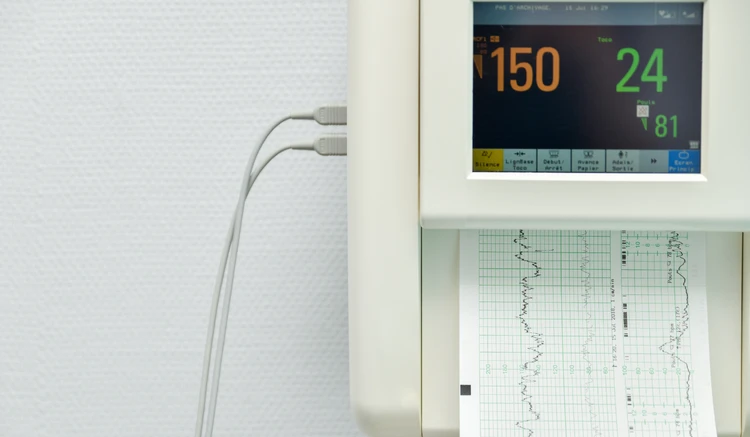If you’re giving birth in a hospital, your doctor will probably use continuous fetal monitoring to show your contractions on a monitor.
The monitor’s screen shows how strong your contractions are, how long they’re lasting, and how far apart they are.
But what do contractions on a monitor actually look like?
And what do they tell you about how things are going?
We’re going to explore the different approaches to monitoring contractions.
And we’ll show you how to make sense of what’s on the screen.
In this article: 📝
- Different types of monitoring
- What is electronic fetal monitoring?
- How to read a contraction monitor
- What do contractions look like on a monitor?
- A final word on reading contractions on a monitor
Different types of monitoring
If you’re giving birth in a hospital, it’s very likely that you’ll be hooked up to a contraction monitor.
Every time you have a contraction – even if you have an epidural and can’t feel them – it’ll show up on the screen as a little mountain, sort of like the peaks and valleys on a lie detector test.
Not every woman in labor is hooked up to a monitor, though.
Sometimes a doctor or midwife uses intermittent monitoring, called auscultation.
This involves listening to the baby’s heartbeat.
It’s sometimes the preferred approach if you are considered to have a low risk pregnancy.
But you’ll probably have continuous fetal monitoring if you are:
- Using an epidural
- Being administered pitocin, such as in an induced labor
- A high-risk pregnancy
- Have pre-existing medical conditions, like diabetes or hypertension
Continuous monitoring is done by a process called electronic fetal monitoring.
What is electronic fetal monitoring?
Electronic fetal monitoring looks at both the baby’s heart rate and your contractions.
Sometimes it uses equipment placed inside your body, and sometimes it’s done externally.
Most often, external monitoring is used.
This involves a piece of equipment called an ultrasound transducer that’s strapped over your belly to monitor your baby’s heartbeat.
A second monitor goes over the top of your abdomen to measure your contractions.
Internal monitoring can be carried out using an Intrauterine Pressure Catheter, or IUPC.
This measures the pressure within the amniotic space while contractions are happening.
A tiny electrode will also be inserted into your vagina and placed on your baby’s scalp to monitor their heartbeat.

How to read a contraction monitor
With continuous monitoring, the readings from the monitor will show up on a screen.
The screen will most likely be close to your bed (and possibly, annoyingly loud…).
If you’re wondering how to read contractions on a monitor, here’s what to look for:
The same screen will usually show both your baby’s heart rate and your contractions on two separate graphs.
The graph showing the baby’s heart rate is normally displayed above the one showing your contractions.
The graphs are constantly updating and moving across the screen, right to left.
That means that whatever is happening on the right of the screen is the most recent information.
The x-axis of the contraction monitor
For both graphs – heart rate and contractions – the horizontal x-axis measures time in minutes.
That’s the straight line that goes across the screen and doesn’t change.
The y-axis of the contraction monitor
The vertical y axes for the two graphs – the lines that go up and down – are different.
For the baby’s heart rate graph, the y-axis shows beats per minute.
For the contractions graph, it will show a measurement called mmHg.
That stands for millimeters of mercury, and it measures how strong the contraction is.
In the later first stage of labor, contractions typically measure between 25 and 50 mmHg.
That increases to between 80 and 100 mmHg in the second stage.
(You can find out more about the different stages of labor here.)

What do contractions look like on a monitor?
They appear as peaks on that lower graph.
By looking at those peaks, you can see how often contractions are taking place, how long they last, and how strong they are.
A wider peak means a longer contraction.
The closer together they appear, the more frequently they’re happening.
And the higher the peak, the stronger the contraction.
If this is your first pregnancy, and you’re wondering what contractions feel like, we’ll take you through it.
A final word on reading contractions on a monitor
Being able to understand what your contractions monitor is showing can be very reassuring.
But it’s also important to know that monitoring isn’t always perfect.
Equipment can slip out of place, or there can be a false alarm if your baby shifts position.
So there’s no need to panic if the machine suddenly starts beeping wildly.
Your healthcare practitioner will be on hand to keep an eye on everything.
They’ll be able to check what’s happening and take any necessary action.
And if you have questions, don’t be afraid to ask the Peanut community.
You’ve got this, mama!

